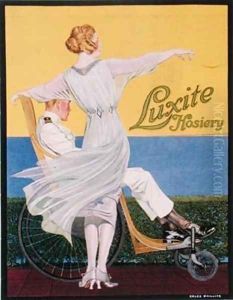C. Coles Phillips Paintings
Clarence Coles Phillips, commonly known as C. Coles Phillips, was an American artist and illustrator renowned for his work in advertising and for creating cover art for popular magazines during the early 20th century. Born on October 3, 1880, in Springfield, Ohio, Phillips demonstrated an early interest in art and pursued his passion by studying at the Kenyon College in Gambier, Ohio. Later, he moved to New York City to further his studies at the Art Students League.
Phillips began his artistic career creating illustrations for advertisements and soon gained recognition for his unique style. His breakthrough came with his creation of the 'Fadeaway Girl' concept, in which he incorporated the figure of a woman into the design's background. The figure's clothing would often seamlessly blend with the surrounding environment, creating a clever visual effect that became his signature style. This technique was not only innovative but also caught the viewer's attention, making it highly effective for the advertising industry.
C. Coles Phillips' work became synonymous with the 'Life' magazine covers, where many of his 'Fadeaway Girl' illustrations were published. His covers for 'Life' were so popular that they significantly boosted the magazine's sales. In addition to 'Life', his works were featured in other periodicals such as 'Good Housekeeping', 'The Saturday Evening Post', and 'Ladies' World'. Phillips also compiled several of his 'Fadeaway Girl' images into a book titled 'A Gallery of Girls', which was published in 1911.
Despite his commercial success, Phillips faced health challenges throughout his life, including tuberculosis. His health issues did not deter him from producing a substantial body of work, which continued to be celebrated for its elegance, charm, and innovation. Unfortunately, his career was cut short when he passed away on June 13, 1927, at the age of 46. Today, C. Coles Phillips is remembered as a pioneer in the field of advertising art and a contributor to the visual culture of the early twentieth century.
